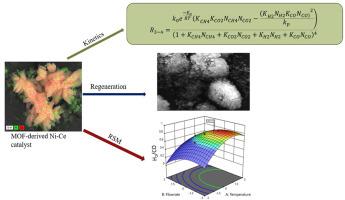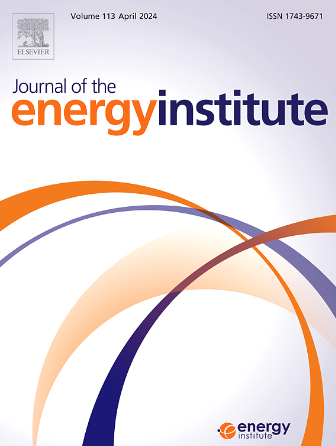Kinetics, response surface methodology, and regeneration studies of MOF-derived Ni-Ce catalyst for dry reforming of methane
IF 5.6
2区 工程技术
Q2 ENERGY & FUELS
引用次数: 0
Abstract
The MOF-derived bimetallic Ni-Ce catalyst was studied under three major headings: kinetics, stability and regeneration, and response surface methodology (RSM). The impact of reaction temperature and inlet gas flowrate on H2/CO, CO2 and CH4 conversions in DRM were determined by using RSM and design of experiment (DOE). Optimal values, determined through RSM evaluation, revealed CO2 and CH4 conversions and H2/CO ratio of 99 %, 96 %, and 0.98, respectively, achieved at a reaction temperature of 793 °C and an inlet flowrate of 0.03 mol/h. Furthermore, the kinetic assessment was evaluated using six kinetic models, with reversible Langmuir Hinshelwood and Power law models identified as the best fits. Also, the stability and 2-cycle regeneration analysis at 700 °C, 0.033 mol/h inlet gas flowrate, and a 1:1 CH4:CO2 ratio, showed the MOF-derived Ni-Ce catalyst stability and better regeneration was observed under CO₂ compared to air, as air regeneration caused a higher degree of sintering on the catalyst than CO₂ regeneration.

用于甲烷干重整的 MOF 衍生 Ni-Ce 催化剂的动力学、响应面方法和再生研究
研究从 MOF 衍生的双金属 Ni-Ce 催化剂的三个主要方面:动力学、稳定性和再生以及响应面方法 (RSM)。利用 RSM 和实验设计 (DOE) 确定了反应温度和入口气体流速对 DRM 中 H2/CO、CO2 和 CH4 转化率的影响。通过 RSM 评估确定的最佳值显示,在反应温度为 793 °C 和入口流量为 0.03 mol/h 时,CO2 和 CH4 转化率以及 H2/CO 比率分别为 99 %、96 % 和 0.98。此外,还使用六种动力学模型对动力学进行了评估,结果表明可逆的朗缪尔-钦谢伍德模型和幂律模型最符合要求。此外,在 700 °C、0.033 mol/h 入口气体流速和 1:1 CH4:CO2 比率条件下进行的稳定性和 2 周期再生分析表明,MOF 衍生的 Ni-Ce 催化剂具有稳定性,与空气相比,在 CO₂ 条件下再生效果更好,因为与 CO₂ 再生相比,空气再生会导致催化剂烧结程度更高。
本文章由计算机程序翻译,如有差异,请以英文原文为准。
求助全文
约1分钟内获得全文
求助全文
来源期刊

Journal of The Energy Institute
工程技术-能源与燃料
CiteScore
10.60
自引率
5.30%
发文量
166
审稿时长
16 days
期刊介绍:
The Journal of the Energy Institute provides peer reviewed coverage of original high quality research on energy, engineering and technology.The coverage is broad and the main areas of interest include:
Combustion engineering and associated technologies; process heating; power generation; engines and propulsion; emissions and environmental pollution control; clean coal technologies; carbon abatement technologies
Emissions and environmental pollution control; safety and hazards;
Clean coal technologies; carbon abatement technologies, including carbon capture and storage, CCS;
Petroleum engineering and fuel quality, including storage and transport
Alternative energy sources; biomass utilisation and biomass conversion technologies; energy from waste, incineration and recycling
Energy conversion, energy recovery and energy efficiency; space heating, fuel cells, heat pumps and cooling systems
Energy storage
The journal''s coverage reflects changes in energy technology that result from the transition to more efficient energy production and end use together with reduced carbon emission.
 求助内容:
求助内容: 应助结果提醒方式:
应助结果提醒方式:


